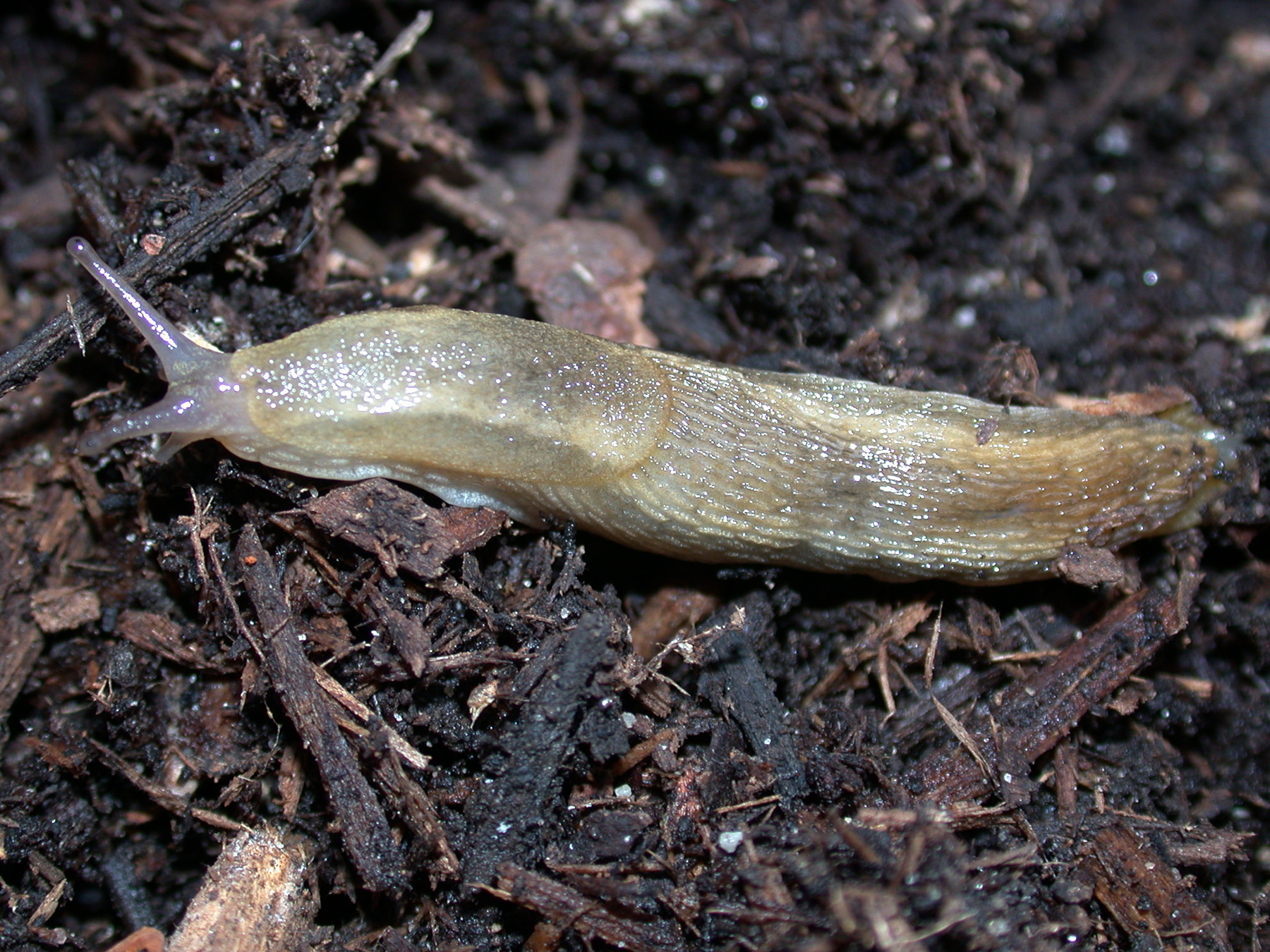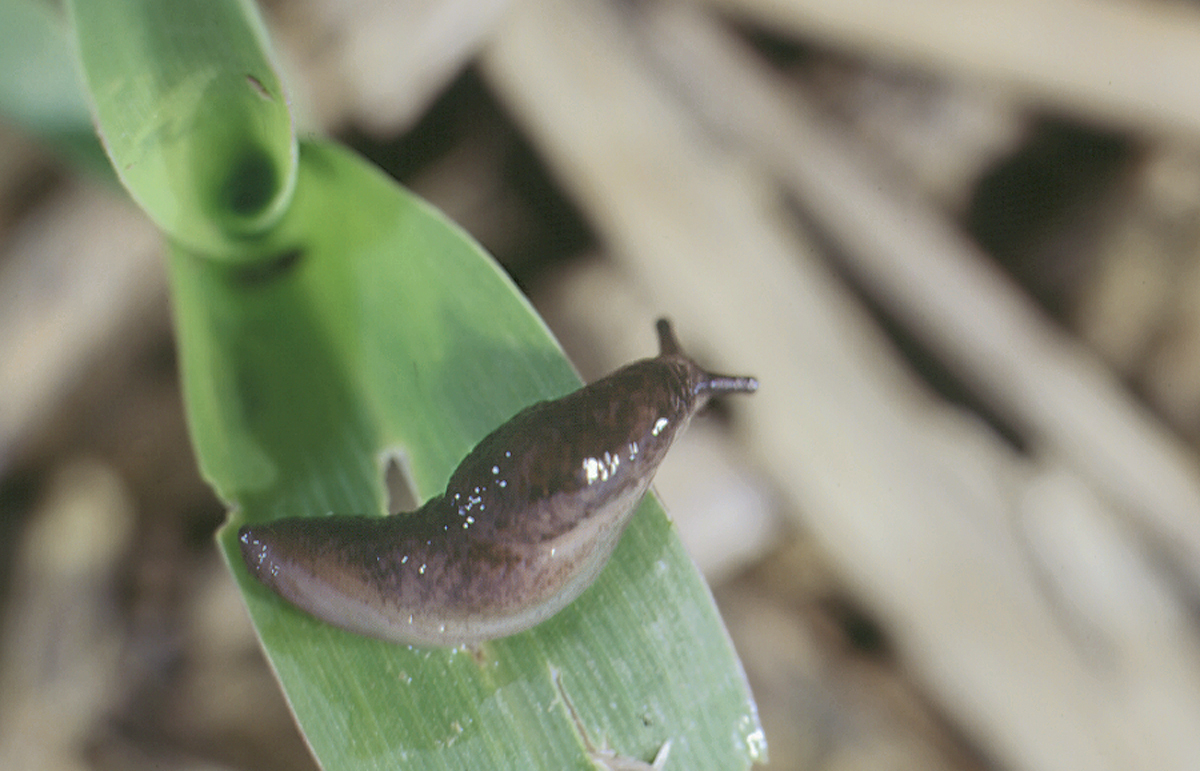Landscape & Ornamental
SLUGS IN HOMES, GARDENS, AND GREENHOUSES
Timothy J. Gibb and Clifford S. Sadof, Extension Entomologists
If you want to view as pdf, click here
Slugs are soft-bodied, grayish or mottled, slimy creatures that can sometimes measure up to 4 inches in length, although most grow to only 1 1/2 inches. Slugs feed on molds and decaying organic matter, but may also feed on the foliage of plants. They must have a large amount of moisture to survive, and they prefer darkness. Ideal habitats include damp basements, beneath boards, trash and other debris, and in crevices. In gardens, mulches of leaves, grass, or other organic materials may encourage slug problems. In greenhouses, rotting boards, flower pots, and debris beneath the benches usually harbor these pests. Excessively rainy and damp weather promotes slug development, especially if temperatures are high.
Slugs are active at night and leave a silver-colored, slimy trail wherever they travel. These trails can be seen on foundation walls, basement floors, walks, and even on plant leaves.
A slug in wood chips. (Photo Credit: John Obermeyer)
A black slug on corn leaf. (Photo Credit: John Obermeyer)
CONTROL MEASURES
Chemical Pesticides
Metaldehyde and Mesurol (Methiocarb) in bait form are the preferred materials for killing slugs in gardens and greenhouses. Most garden supply centers sell “slug and snail bait” that contains metaldehyde or Mesurol. Apply the bait according to the package directions. This product is toxic to pets. They must be excluded before and after application.
A 15% metaldehyde dust is preferred for slug control in greenhouses. It is not generally available except from greenhouse suppliers. Three treatments at 10-day intervals are usually sufficient. Wear a respirator, and apply evenly to surfaces over which slugs crawl. An application of diatomaceous earth to areas where slugs crawl is an effective organic control.
Sanitation
Slugs can often be controlled simply by eliminating their hiding places. Remove rotting boards and debris left on the ground or stored in the basement. Pay special attention to keeping the crawl space under the house free of trash. The same holds true for the area under the benches in a greenhouse. Items stored on the ground or floor trap moisture and promote slug breeding conditions. Keep gardens weeded and surrounding grass cut short. Trim lower leaves or stake plants to keep leaves off the ground. Promote air circulation to dry the soil surface.
Other Methods
Some reports suggest that small pans, canning lids, or dishes at least 1/2 inch deep, sunk into the ground at 3-4 feet intervals, and filled with beer, may attract and drown garden slugs. The containers must be refilled when they dry out or are washed out after a rain.
Slugs also can be controlled by hand-collecting. Do this early in the morning or soon after dark. Trapping them by laying old boards between garden rows and collecting the slugs the next morning is also effective in home gardens.
READ AND FOLLOW ALL LABEL INSTRUCTIONS. THIS INCLUDES DIRECTIONS FOR USE, PRECAUTIONARY STATEMENTS (HAZARDS TO HUMANS, DOMESTIC ANIMALS, AND ENDANGERED SPECIES), ENVIRONMENTAL HAZARDS, RATES OF APPLICATION, NUMBER OF APPLICATIONS, REENTRY INTERVALS, HARVEST RESTRICTIONS, STORAGE AND DISPOSAL, AND ANY SPECIFIC WARNINGS AND/OR PRECAUTIONS FOR SAFE HANDLING OF THE PESTICIDE.
April 2018

It is the policy of the Purdue University Cooperative Extension Service that all persons have equal opportunity and access to its educational programs, services, activities, and facilities without regard to race, religion, color, sex, age, national origin or ancestry, marital status, parental status, sexual orientation, disability or status as a veteran. Purdue University is an Affirmative Action institution. This material may be available in alternative formats.
This work is supported in part by Extension Implementation Grant 2017-70006-27140/ IND011460G4-1013877 from the USDA National Institute of Food and Agriculture.
1-888-EXT-INFO
www.extension.purdue.edu
Order or download materials from www.the-education-store.com




